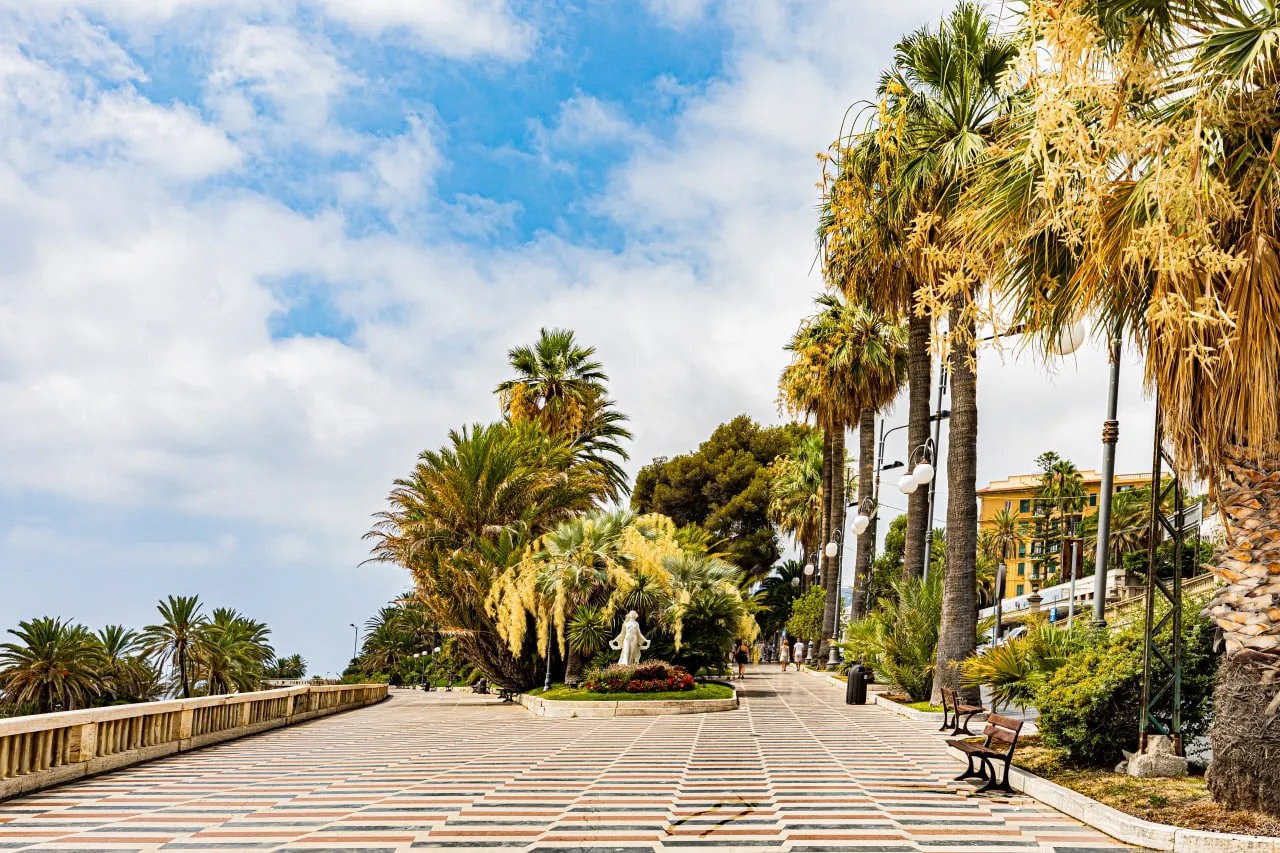
Visit Sanremo
Sanremo, a long history . . .
The historic center of Sanremo is a visual witness of the ancient history of the city, founded in Roman times, the Matuzia Villa, then developed in the Middle Ages, in its characteristic shape of Pine as the fruit (name derived precisely from its similarity to a pine cone) up to between the nineteenth and twentieth centuries to a Ville de Saison that is a city with a rather mild and sweet climate, suitable for the wintering of the rich bourgeois of the time.
From the end of the XIX century its history and urbanism has expanded seeing to rise the structures in the style of beautiful Epoque of which the Grand Hotel & Des Anglais is part, becoming a tourist destination of the Grand Tour and hosting many prominent historical figures and artists such as Winston Churchil, Gabriele D'annunzio, Guglielmo Marconi, Alfred Nobel.
Our WALKING ITINERARY
1. PASSEGGIATA IMPERATRICE
Excellent starting point from the hotel for an exotic walk on Corso Imperatrice, in the shade of its very tall palm trees, delivered to the city of Sanremo as a gift from Tsarina Alexandrovna in 1874. The regal seafront is richly embellished with white, red and black marble paving and from it you can enjoy a splendid maritime panorama and the Statue of Spring, sculptor Vincenzo Pasquali and symbol of the City. The Imperatrice promenade is one of the most prestigious on the Riviera and extends towards the centre, overlooking the beaches, and surrounded upstream by its historic and numerous hotels, in splendid Art Nouveau style.
2. RUSSIAN ORTHODOX CHURCH
A sudden wonder can be seen as you continue the walk, the fairy-tale Russian Orthodox Church, built in the early 1900s, by will of the various Russian aristocratic families who owned multiple villas and spent long periods ”wintering“ in Sanremo.
3. MUNICIPAL CASINO
Heading east, we will encounter the Municipal Casino of Sanremo, designed by the French architect Eugène Fernet, the only one of the four casinos present in Italy, built in 1905. It is a splendid Art Nouveau building which retains its splendor with its interior the Casino Theatre, the Slot Machine Room and the Gaming Table Room.
4. SAN SIRO CATHEDRAL AND CIAPELA TOWER
Continuing Via Giacomo Matteotti you will reach the Cathedral of San Siro, the religious building is older than Sanremo. In Romanesque style, it preserves a splendid original mosaic inside, reproduced on the main façade. The church was renovated several times following various bombings, thus changing its architectural appearance. The characteristic cobbled streets surround it, full of craft shops and cafés and from one of them you reach the Annonario Market with its ancient Saracen Tower.
5. LA PIGNA - OLD TOWN
Treat yourself to a walk in ancient Pigna, the heart of the old city, on a journey back in time to explore the ancient medieval fortified village which is still inhabited and can be reached through various gates. The most famous and characteristic is the Porta di Santo Stefano, accessible from Via Cavour; it served as a fortified entrance and the houses themselves constituted the fortification of the citadel, often targeted by the incursions of the Barbary Pirates. The inhabited center clings to the hill in concentric circles, covered passages, arches, courtyards, fountains and stairways to reach the sanctuary of the Madonna della Costa at the top, a precious monumental treasure chest that dominates the city. Excellent view from above.
6. PIAZZAN BRESCA, PORTO VECCHIO AND SANTA TECLA
Arriving in the fragrant Piazza Bresca, surrounded by wild orange trees, the beating heart of the nightlife, we continue towards the old port, with 806 berths it has become a point of reference for national and international boating but also a convivial meeting point where you can have a drink aperitif kissed by the sea breeze or enjoy an excellent meal based on fresh fish. The backdrop is the ancient pastel-coloured maritime houses, the long quay of the port, which seems to embrace the boats and is an excellent panoramic point, and the fort of SANTA TECLA, an interesting example of an eighteenth-century Ligurian military fortification. Today it has been renovated and is used as an exhibition space offering exhibitions and cultural initiatives, where it is possible to access it according to the opening hours.
7. ARISTON THEATER
Returning to the heart of Sanremo, walk along Via Giacomo Matteotti, paying attention to the bronze plaques placed in the center of the street, which indicate the winners of the Sanremo Festival. Each plaque indicates the song title, year and winning artist. Take a photo with the bronze statue of the legendary Mike Bongiorno. At the end of the street you will reach the famous Ariston Theatre, known by all for the Italian song festival, which offers high-profile theater seasons and also has a small internal museum that can be visited.
8. SHOPPING VIA GIACOMO MATTEOTTI.
Elegant pedestrian street in the heart of the centre, it features designer boutiques, artisan shops selling clothing, bags, perfumes and jewelery but also many places where you can taste the typical Sardenaria or have an aperitif in company. Smell the refined perfumes of the Riviera dei Fiori produced by the Daphne company.
